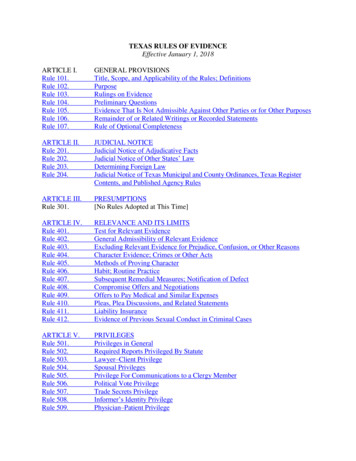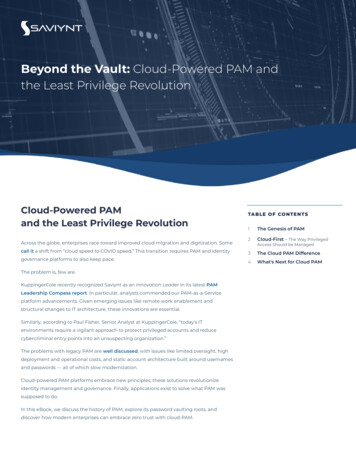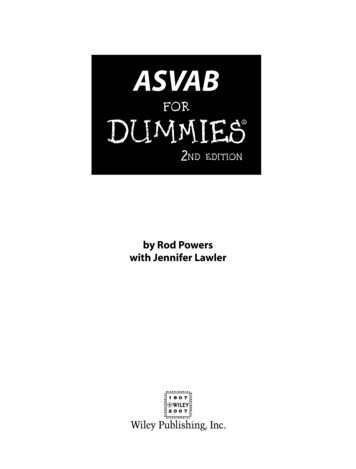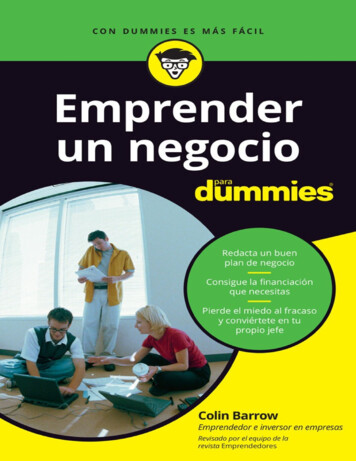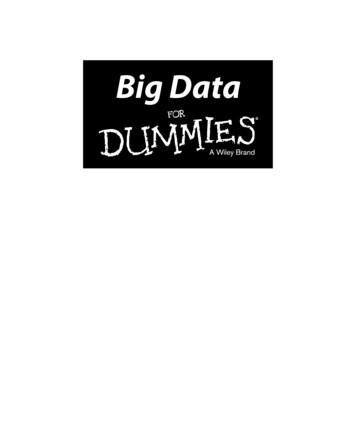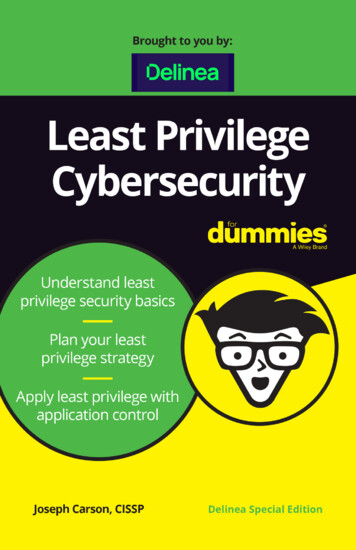
Transcription
About DelineaDelinea is a leading provider of privileged access management (PAM) solutionsfor the modern, hybrid enterprise and makes privileged access more accessibleby eliminating complexity, enforcing Zero Trust, and seamlessly defining theboundaries of access. Delinea simplifies security, ensures compliance andreduces risk for thousands of customers, over half the Fortune 100, and theworld’s largest financial institutions, intelligence agencies and criticalinfrastructure companies. For more information, go to www.delinea.com
Least PrivilegeCybersecurityDelinea Special Editionby Joseph Carson, CISSPThese materials are 2022 John Wiley & Sons, Inc. Any dissemination, distribution, or unauthorized use is strictly prohibited.
Least Privilege Cybersecurity For Dummies ,Delinea Special EditionPublished byJohn Wiley & Sons, Inc.111 River St.Hoboken, NJ 07030-5774www.wiley.comCopyright 2022 by John Wiley & Sons, Inc.No part of this publication may be reproduced, stored in a retrieval system or transmitted in any formor by any means, electronic, mechanical, photocopying, recording, scanning or otherwise, except aspermitted under Sections 107 or 108 of the 1976 United States Copyright Act, without the prior writtenpermission of the Publisher. Requests to the Publisher for permission should be addressed to thePermissions Department, John Wiley & Sons, Inc., 111 River Street, Hoboken, NJ 07030, (201) 748-6011,fax (201) 748-6008, or online at http://www.wiley.com/go/permissions.Trademarks: Wiley, For Dummies, the Dummies Man logo, The Dummies Way, Dummies.com, MakingEverything Easier, and related trade dress are trademarks or registered trademarks of John Wiley & Sons,Inc. and/or its affiliates in the United States and other countries, and may not be used without writtenpermission. Delinea and the Delinea logo are trademarks of Delinea. All other trademarks are theproperty of their respective owners. John Wiley & Sons, Inc., is not associated with any product orvendor mentioned in this book.LIMIT OF LIABILITY/DISCLAIMER OF WARRANTY: WHILE THE PUBLISHER AND AUTHORS HAVEUSED THEIR BEST EFFORTS IN PREPARING THIS WORK, THEY MAKE NO REPRESENTATIONS ORWARRANTIES WITH RESPECT TO THE ACCURACY OR COMPLETENESS OF THE CONTENTS OF THIS WORKAND SPECIFICALLY DISCLAIM ALL WARRANTIES, INCLUDING WITHOUT LIMITATION ANY IMPLIEDWARRANTIES OF MERCHANTABILITY OR FITNESS FOR A PARTICULAR PURPOSE. NO WARRANTYMAY BE CREATED OR EXTENDED BY SALES REPRESENTATIVES, WRITTEN SALES MATERIALS ORPROMOTIONAL STATEMENTS FOR THIS WORK. THE FACT THAT AN ORGANIZATION, WEBSITE, ORPRODUCT IS REFERRED TO IN THIS WORK AS A CITATION AND/OR POTENTIAL SOURCE OF FURTHERINFORMATION DOES NOT MEAN THAT THE PUBLISHER AND AUTHORS ENDORSE THE INFORMATIONOR SERVICES THE ORGANIZATION, WEBSITE, OR PRODUCT MAY PROVIDE OR RECOMMENDATIONS ITMAY MAKE. THIS WORK IS SOLD WITH THE UNDERSTANDING THAT THE PUBLISHER IS NOT ENGAGEDIN RENDERING PROFESSIONAL SERVICES. THE ADVICE AND STRATEGIES CONTAINED HEREIN MAY NOTBE SUITABLE FOR YOUR SITUATION. YOU SHOULD CONSULT WITH A SPECIALIST WHERE APPROPRIATE.FURTHER, READERS SHOULD BE AWARE THAT WEBSITES LISTED IN THIS WORK MAY HAVE CHANGEDOR DISAPPEARED BETWEEN WHEN THIS WORK WAS WRITTEN AND WHEN IT IS READ. NEITHER THEPUBLISHER NOR AUTHORS SHALL BE LIABLE FOR ANY LOSS OF PROFIT OR ANY OTHER COMMERCIALDAMAGES, INCLUDING BUT NOT LIMITED TO SPECIAL, INCIDENTAL, CONSEQUENTIAL, OR OTHERDAMAGES.For general information on our other products and services, or how to create a custom For Dummies bookfor your business or organization, please contact our Business Development Department in the U.S. at877-409-4177, contact info@dummies.biz, or visit www.wiley.com/go/custompub. For information aboutlicensing the For Dummies brand for products or services, contact BrandedRights&Licenses@Wiley.com.ISBN: 978-1-119-88724-9 (pbk); ISBN: 978-1-119-88725-6 (ebk). Some blank pages in the print versionmay not be included in the ePDF version.Publisher’s AcknowledgmentsSome of the people who helped bring this book to market includethe following:Project Manager:Carrie Burchfield-LeightonSr. Managing Editor: Rev MengleAcquisitions Editor: Ashley CoffeyBusiness DevelopmentRepresentative: Matt CoxThese materials are 2022 John Wiley & Sons, Inc. Any dissemination, distribution, or unauthorized use is strictly prohibited.
IntroductionCompanies are spending billions on cybersecurity, yet hackers, cybercriminals, and disgruntled employees continue breaching computer systems, stealing sensitive information, or disrupting services. With more than 80 percent ofbreaches involving the compromise of IT and business usercredentials (IDs and passwords), organizations want to limit what’s known as privileged access to services, applications, data,and systems — a concept called least privilege cybersecurity.Privileged accounts exist everywhere in your IT environment. Inmany cases, users may not even realize the type of access theypossess. They only know that when access is denied, they can’t gettheir work done. Hackers and cybercriminals target these privileged accounts because once compromised, they give the ability tomove across your systems and networks undetected.Despite efforts to raise cyber awareness and train users on securebehavior, nearly one in four employees will open phishing emails,and more than one in ten will click on an attachment that containsmalware. These types of successful social engineering attacks areone reason employee workstations and personal devices are themost vulnerable part of your IT systems. All it takes is one compromised user with local administrative privileges to gain fullcontrol or even take down your entire network.About This BookOrganizations today typically face major challenges when seeking to implement least privilege because built-in limits on accesscan impact employee productivity. If users can’t get access toan account, a service, or a device such as a printer, they have tospend time calling the IT helpdesk for a “fix.” In many cases,busy IT helpdesk workers may give users more privileges thanneeded to expedite resolution of user problems. Least privilegeis meant to prevent “overprivileged access” by users, applications, and services to help reduce the risk of exploitation withoutimpacting productivity.Introduction1These materials are 2022 John Wiley & Sons, Inc. Any dissemination, distribution, or unauthorized use is strictly prohibited.
This book is a first step in understanding the mechanics and valueof implementing a least privilege cybersecurity strategy. It givesyou the basic principles behind least privilege as well as how to planyour own strategy with key actions to get started. Note: Throughout this book, the phrases “least privilege cybersecurity,” “leastprivilege security,” and “least privilege” are used interchangeably.I wrote this book for IT managers, administrators, systemsadministrators, and security professionals who are responsible forprotecting their organizations from hackers, cybercriminals, andmalicious insider threats. I assume a basic level of IT expertiseand experience, including familiarity with IT networks and the useof privileged accounts (human and non-human) across the organization. Least Privilege Cybersecurity For Dummies, Delinea SpecialEdition, provides an easily digestible introduction to the conceptof least privilege cybersecurity for business executives and users.Icons Used in This BookThis book uses the following icons to indicate special content:You don’t want to forget this information. It’s essential to gain abasic understanding of least privilege cybersecurity.This icon indicates more technical information that is of mostinterest to IT and system administrators.The Tip icon points out practical advice that saves you timeand effort in putting together your own least privilege securitystrategy.Beyond the BookDeveloping, implementing, and enforcing least privilege cybersecurity only begins with this book. To learn more, visit www.Delinea.com. You’ll find resources, including free software tools,white papers, videos, and product information, that help explainand manage least privilege security.2Least Privilege Cybersecurity For Dummies, Delinea Special EditionThese materials are 2022 John Wiley & Sons, Inc. Any dissemination, distribution, or unauthorized use is strictly prohibited.
IN THIS CHAPTER»» Getting started with zero trust»» Classifying users»» Enforcing least privilege»» Meeting complianceChapter1Defining Least PrivilegeCybersecurityLeast privilege cybersecurity enables enforcement of a zero trustrisk-based security model whereby once a user is verified, theuser’s access is limited to only what’s necessary to accomplish the specific task or job. If any user action requires moreaccess than granted via policy rules, permissions to elevateprivileges are strictly controlled and monitored. While simple in concept, enforcing least privilege in IT environments can be highlycomplex and involve hundreds, if not thousands, of users, applications, and services that need access to privileged permissions.Starting from Zero TrustZero trust assumes any user or system that accesses the network,services, applications, data, or systems starts with zero trust. Togain authorized access, trust must be earned by the prospectiveuser through verification. For example, verification can requiretwo-factor authentication. In this instance, a user providesa password but then must take an additional step by using anauthentication application. When new devices are introduced onthe network — and before they obtain access to any resources —they must first identify and verify themselves based on variousCHAPTER 1 Defining Least Privilege Cybersecurity3These materials are 2022 John Wiley & Sons, Inc. Any dissemination, distribution, or unauthorized use is strictly prohibited.
security controls. The more sensitive the resources to be accessed,the more security controls they must satisfy.Cybersecurity should always begin with zero trust, ensuring thatonly authorized access is permitted. After verification of identityis established, users can be classified according to the access theyneed to perform their jobs.Classifying Trust DynamicallyCybersecurity classifications of trust and accepted risk should bedynamic. This means you need to create policies or rules acrossthe enterprise for identities, services, applications, data, and systems. For example, you can have an “always verify” and “alwaysmonitor” policy for third-party vendors or contractor identities.Internal employee classifications would be adaptive based on thesensitivity of the data being accessed.An always verify policy would require credentials and multifactorauthentication, while an always monitor policy would audit andrecord all activity.PREVENTING THE EXPLOITATIONOF OVERPRIVILEGED USERSMany times, companies inadvertently give their employees too muchaccess to account information. This oversight results in overprivilegedusers and can lead to breaches within your company. Take Sarah, forexample, who is an employee at a manufacturing company. As an easyway for her to perform her job, she’s been given a laptop that has localadministrator admin account rights. In effect, the local admin accountgives her relatively unlimited access to run applications, even thoughshe may not be aware of it. She has just become an overprivileged user.One day, Sarah receives an email with an attached document that appearsto be a legitimate request from the CEO of the company. She clicks onthe attachment, and unbeknown to Sarah, she downloads malicioussoftware that kicks off processes that capture her user ID and password.Because Sarah’s computer contains local admin rights, the malware hassucceeded in editing the computer’s registry, allowing the malware —and the cybercriminal — to persist on Sarah’s computer. Without Sarah4Least Privilege Cybersecurity For Dummies, Delinea Special EditionThese materials are 2022 John Wiley & Sons, Inc. Any dissemination, distribution, or unauthorized use is strictly prohibited.
realizing it, the malware has also captured the hashes of Sarah’s credentials, allowing it to traverse other areas within her company’s IT network. The malware covers its tracks by changing audit logs. No oneknows that the cybercriminal is inside the network. And all of thisoccurs through what’s known as a local admin rights takeover — a compromised privileged account resulting from an overprivileged user.Other classifications are as follows:»» Services and applications can be classified by the sensitivity of the data that the service or application has access to.For example, does it contain sensitive information such ascredit card details or health records?»» Devices can be classified as employee personal devices andcontractor devices, versus corporate owned and managedissued devices. Personal or contractor devices should fallinto the “never trusted” classification because you neverknow what applications or malicious software exists onthese devices to exploit opportunities. Therefore, segmentnetworks to distinguish untrusted networks such as personalor contractor devices, versus trusted networks that canconnect only to known managed corporate systems.Enforcing Least PrivilegeLeast privilege enforcement has two aspects:»» Privacy: When a user logs in, she can only see what she’spermitted to access.»» Security: Based on specific privileged access, a user haslimits on what applications/tasks she can run.Least privilege enforcement typically starts by removing localadministrative privileges on endpoints, such as user laptops ormobile devices, so you can reduce your attack vulnerabilities andprevent most attacks from occurring. Least privilege is effectiveat reducing major patch management headaches. Enforcing leastprivilege security can help eliminate more than 90 percent ofMicrosoft Windows patches because most vulnerabilities requireadmin privileges to exploit them.CHAPTER 1 Defining Least Privilege Cybersecurity5These materials are 2022 John Wiley & Sons, Inc. Any dissemination, distribution, or unauthorized use is strictly prohibited.
A HOTEL ACCESS ANALOGYImplementing zero trust with least privilege may be easier to understand when expressed through a hotel access analogy. Some cybersecurity systems look at verifying employee users at the entrance to thehotel lobby. After the identity of a person is verified, he basically getsa master key with access to all the areas and rooms in the hotel. Hecan roam freely throughout the hotel corridors and enter any roomeven if it’s locked. No one will challenge his actions, and he doesn’tneed anyone to help him gain access. He’s an overprivileged user.However, when least privilege is applied, after the identity is verified,the user gets a key that allows him only into a specific room and/oronto a specific floor. And when least privilege is combined with application control, the individual can enter a room but is limited in hisactions once he’s in the room. He may, for example, be able to turnon a faucet in the bathroom but not open a window. If he tries toopen a window, an alarm will go off, and a hotel security person willinvestigate the potential security risk.Imagine managing thousands of people who enter the hotel to conduct business. Verifying identities at the lobby may seem to be logical,but once a user enters, giving him free access to every room and partof the hotel is extremely risky. At the same time, you don’t want usersto be so restricted in where they can go and what they can do that therestrictions keep them from completing their work.Meeting Compliance RequirementsMany compliance requirements and regulations require strictsecurity controls in the use of privileged access. Organizationsthat provide end-users with too many privileges will alwaysstruggle to satisfy most compliance requirements. And when theydo apply strict controls to meet regulations, they can negativelyimpact user productivity. Thus, it’s critical to create a least privilege strategy that both restricts end-users’ privileges withoutpreventing employees from performing tasks needed to successfully do their jobs.6Least Privilege Cybersecurity For Dummies, Delinea Special EditionThese materials are 2022 John Wiley & Sons, Inc. Any dissemination, distribution, or unauthorized use is strictly prohibited.
IN THIS CHAPTER»» Finding your most critical assets»» Matching privileged accounts to criticalassets»» Establishing a PAM program»» Implementing a least privilege life cycleapproachChapter2Getting Started withLeast PrivilegeThis chapter highlights the key functions you must performto set the proper course for your least privilege securityjourney. They provide the foundational elements that allowyou to implement least privilege enforcement tailored to yourspecific organization’s assets and business model.Identifying Critical AssetsA risk-based approach to cybersecurity enables you to determinewhat assets to protect, what security controls you need, and whatsecurity challenges you must address to effectively reduce risks.Start with a data impact assessment to determine what services,applications, data, and systems are most critical to your specificbusiness, along with compliance and regulations you must meet.You must identify those critical data assets that, if compromised,could cause either major financial harm or disruption of businessservices.CHAPTER 2 Getting Started with Least Privilege7These materials are 2022 John Wiley & Sons, Inc. Any dissemination, distribution, or unauthorized use is strictly prohibited.
Mapping Privileged Accountsto Critical AssetsAfter you’ve identified your most critical information assets, youcan then define what kind of privileged accounts are associatedwith these assets:»» Human (interactive) services, applications, or systems»» Accessible via hardware, software, on-premises, or in thecloud»» Used in internal networks or by external services»» How often they’re used»» Department or location specific»» Sensitivity of the service, application, or data the account isprotecting»» Service or system owner for accountabilityIncorporating the Privileged AccessManagement Life CycleLike any IT security measure designed to help protect criticalinformation assets, managing and protecting privileged accountaccess requires both a plan and an ongoing program. You mustidentify which privileged accounts should be a priority in yourorganization and ensure that those employees who are usingthese privileged accounts understand acceptable use and theirresponsibilities.Figure 2-1 illustrates a privileged access management (PAM) lifecycle approach that should be incorporated into your least privilege strategy to»» Define privileged access and accounts»» Discover privileged accounts continuously»» Manage, secure, protect, and control privileged accounts»» Audit and monitor usage8Least Privilege Cybersecurity For Dummies, Delinea Special EditionThese materials are 2022 John Wiley & Sons, Inc. Any dissemination, distribution, or unauthorized use is strictly prohibited.
»» Investigate unusual behavior»» Respond to incidents»» Review and evaluate privilege access controlsDEFINEREVIEW &AUDITDISCOVERMANAGE &PROTECTRESPOND TOINCIDENTSDETECTABNORMAL USAGEMONITORFIGURE 2-1: The PAM life cycle.Your next step in implementing a least privilege strategy will beto determine privilege usage across your environment based onhow you define privileged access:»» Who has privileged access»» When it is being used»» What actions require privileged access»» What security controls should be applied»» Compliance requirements associated with privileged accessTaking a Least PrivilegeLife Cycle ApproachAfter identifying your critical assets, mapping them to privilegedaccounts, incorporating PAM, and defining privilege usage, you’reready for least privilege implementation.CHAPTER 2 Getting Started with Least Privilege9These materials are 2022 John Wiley & Sons, Inc. Any dissemination, distribution, or unauthorized use is strictly prohibited.
A sustainable least privilege strategy isn’t something that can beset up overnight. It takes planning, collaboration, and the righttools to meet the needs of security, IT, desktop support, and users.In taking a least privilege life cycle approach, you increase yourodds of implementation success. When trying to achieve leastprivilege cybersecurity in your organization, follow these keysteps:»» Conduct discovery to find out which endpoints and localusers have admin rights, what applications are in use, and ifthey require admin rights to run.»» Create an allowlist of acceptable trusted applications andprocesses.»» Block known bad files with a denylist or incorporate areputation service.»» Manage unknown areas with a restrictlist and an automatedworkflow to allow approved apps to run and to blockmalicious apps.»» Set contextual policies that align with the risk assessment.»» Plan for users to change roles or departments.»» Don’t limit yourself to domain-controlled endpoints only.»» Don’t forget child processes.»» Integrate workflow into existing tools.»» Measure success coverage and existing risks.»» Enable user interactive elevation requests/workflows.This book focuses on the topic of least privilege cybersecurityapplied to an end-user due to many major cyber incidents resulting from overprivileged users. Overprivileged users are the bestplace to start applying least privilege security; however, it canreadily be extended to any privileged account, even non-humansystem, application, service, or domain accounts.10Least Privilege Cybersecurity For Dummies, Delinea Special EditionThese materials are 2022 John Wiley & Sons, Inc. Any dissemination, distribution, or unauthorized use is strictly prohibited.
IN THIS CHAPTER»» Creating a list of your devices andsoftware»» Integrating compliance requirements»» Combining least privilege with PAM tocontrol access»» Adding application control»» Managing users’ privilegesChapter3Five Actions to LeastPrivilege SuccessIn this chapter, I give you five action steps that set you on theright path to a successful least privilege implementation journey. These steps highlight the key stages of activity but areshortened and simplified for this book. They are meant to spurfurther research so you can be fully prepared with the tools youneed to make least privilege cybersecurity a reality.Inventory Devices and SoftwareProduce a comprehensive inventory of your corporate devices,installed software, and software licenses. You also need to determine where applications typically are being installed from, aswell as the software vendors that are approved to be used withinyour organization.During the inventory process, create a list of trusted vendors,including signed certificate and trusted software sources forapproved applications. These could include a software deliveryCHAPTER 3 Five Actions to Least Privilege Success11These materials are 2022 John Wiley & Sons, Inc. Any dissemination, distribution, or unauthorized use is strictly prohibited.
solution, a software catalogue, a network location, or MicrosoftSharePoint. You also need to list the places you don’t want softwarebeing installed from that could include downloaded program files,email attachments, or any download locations on various devices.With a complete device inventory, you can develop policies thatincorporate trusted and untrusted privilege elevation requests.This process ensures employees can use a least privileged accountto perform privileged actions based on approved policies.Integrate Compliance and RegulationsAlmost every organization faces some kind of compliance mandate or regulatory requirement. There have, for example, beenmajor recent updates to regulations such as the Payment CardIndustry Data Security Standard, National Institute of Standardsand Technology, Cyber Essentials, EU General Data ProtectionRegulation, and the California Consumer Privacy Act. They allinclude requirements for data privacy meant to rein in overprivileged access by users. Therefore, you must integrate complianceand regulations that apply to your organization into your dataimpact assessment, risk-based assessment, and privileged accessmanagement (PAM).Combine PAM and Least Privilegeto Control Access and ActionsA PAM solution helps with defining policies, discovering privileged accounts, applying security controls, auditing usage, andalerting abuse. Combining PAM with least privilege securityallows an organization to elevate privilege OnDemand, offer onetime passwords, and increase and decrease privileges based ondynamic risk and threats. PAM helps control privileges, so they’reavailable when needed, and end-users aren’t overprivileged allthe time.12Least Privilege Cybersecurity For Dummies, Delinea Special EditionThese materials are 2022 John Wiley & Sons, Inc. Any dissemination, distribution, or unauthorized use is strictly prohibited.
ARE YOU AUDITING ANDREMOVING UNNEEDEDADMINISTRATOR RIGHTS?Continuous auditing of administrator and privilege usage allows anorganization to determine if the access is still required. This shouldbe done when privileges are set to expire or on a scheduled basis todetermine if privileges need to be updated. This process could meandemoting a user’s privileges to least privilege and applying a policythat enables privileges to be elevated on demand by using previousknown behavior. Therefore, the user can still be productive and leastprivilege can be hidden in the background without any impact orknowledge to the end-user.Incorporate Application ControlApplication control is technology that enables an organization toelevate application privileges so trusted and approved applications can execute even if users don’t inherently have access. Onthe flip side, application control prevents untrusted applicationsfrom executing even if the user has the privileges that permitthem to install applications. If an application is unknown, it canbe “quarantined” and prevented from executing until furtheranalysis determines whether the application is or authentic.Manage/Protect PrivilegesGranted to UsersSeparating least privileged users from privileged accounts allowsan organization much more control and security over how privileges are granted to users and determines a risk-based approachto what’s an accepted risk. This step allows the organization toadopt a zero trust security posture that’s enforced by a least privilege strategy, reducing the risk from cyberattacks but maintaining empowered employees and productivity without the pain.CHAPTER 3 Five Actions to Least Privilege Success13These materials are 2022 John Wiley & Sons, Inc. Any dissemination, distribution, or unauthorized use is strictly prohibited.
Least privilege security with application control are both necessary.Least privilege with application control solutions helps organizations reduce security threats and maintain productive employeeswho can continue performing privileged tasks and actions undertrusted predefined policies. With least privilege alone, you produceunhappy employees and increased helpdesk calls but increasedsecurity. But when you add application control, your employees are empowered and continue to be productive with increasedsecurity working in the background to prevent cyber threats. Atthe same time, this step helps reduce helpdesk calls.The key benefits of implementing a least privilege strategy withapplication control include»» Reduced costs: Save time and money in managing userssecurely.»» Empowered, happier employees: They can perform theirduties without encountering roadblocks.»» Fast tracks compliance: Automate reporting to satisfyauditors.»» Improved security: Block cybercriminals and maliciousinsiders from exploiting password compromise.Applying the core principles of least privilege is a foundationalelement of your cybersecurity strategy. By removing local administrative privileges on endpoints, you reduce your attack surfaceand block the primary attack vector, preventing the vast majorityof attacks from occurring.Before you start implementing next-generation Endpoint Protection Platforms (EPP) or complex Endpoint Discovery andRemediation solutions (EDRs), you should consider a least privilege strategy with application control solution. Proactive protection based on least privilege means less time and resourcesspent detecting an infection, chasing down malicious hackersonce they’ve already entered your network, and remediating thedamage.Let your least privilege cybersecurity journey begin!14Least Privilege Cybersecurity For Dummies, Delinea Special EditionThese materials are 2022 John Wiley & Sons, Inc. Any dissemination, distribution, or unauthorized use is strictly prohibited.
These materials are 2022 John Wiley & Sons, Inc. Any dissemination, distribution, or unauthorized use is strictly prohibited.
WILEY END USER LICENSE AGREEMENTGo to www.wiley.com/go/eula to access Wiley’s ebook EULA.
CHAPTER 1 Defining Least Privilege Cybersecurity 3 er Wile An ib iz ictl ohibited. Chapter 1 IN THIS CHAPTER » Getting started with zero trust » Classifying users » Enforcing least privilege » Meeting compliance Defining Least Privilege

